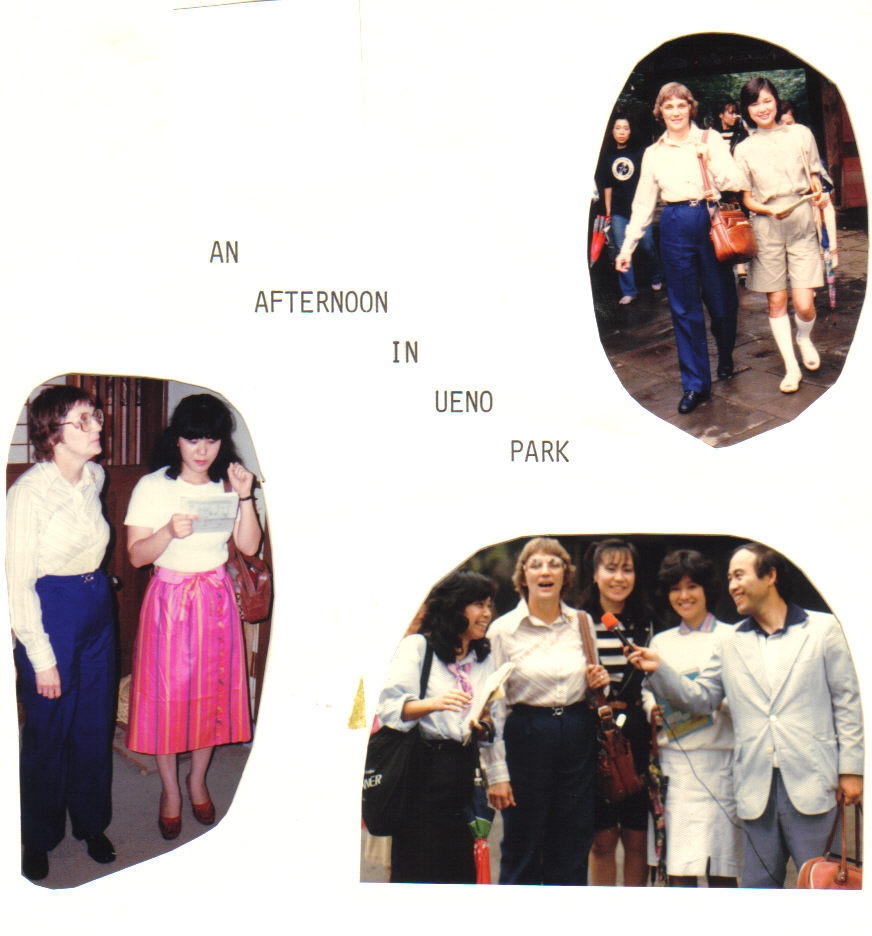[ LLL SIG Website ][ LLL SIG Publications ][ This Issue's Contents ]

Volume 3, Issue 1 [May, 2007]
An afternoon in Ueno Park (Part 1)
Tadashi Ishida
学生時代に英語を勉強した多くの中高年者は、文法規則の暗記や難問解釈に明け暮れ、英語を生きた言葉として学習することが欠けていた。どうしたらこのような生徒に英語は生きた言葉であるという実感を与えることができるだろうか? それには実際に生徒に言語活動をやらせるのが一番良いということに気がついた。なぜなら、言葉というものは、場面や状況に応じて適切な表現が出てくるからである。そこで、外国人に観光案内をするための教科書を作成するという名目で、英語の授業を行うことにした。この授業では、生徒が教科書で学んだ英語を使って外国人に観光案内するのではなく、英語による観光案内の教科書を作る過程で生徒が生きた英語を学べるようにした。
具体的には、東京の台東区社会教育館で英会話を勉強している中高年者に、アメリカの小学校の先生を、日曜日の午後に近くの上野公園に英語で案内してもらうことにした。生徒はまず書籍を読んだり、地元の古老をたずねて、上野公園の観光案内の資料を作成した。その後皆で分担してその資料を英語に直した。当日は英語に直した資料を基に、口頭で先生に説明し、質疑応答を行った。そしてその時録音したテープと撮った写真をもとに、後日、上野公園観光案内の教科書を作成した。生徒はこの言語活動を通じて、英語の4 技能を有機的に統合し、実際的な英語力の運用をはかった。
All over the country, Japanese older learners study English from textbooks, but very few of them get the chance to actually use English with a real live foreigner. This is the first in a series of articles which will chronicle one exception to this situation experienced by a group of my learners who were studying English in a community center in Taito Ward in Tokyo. After doing considerable research and preparation, and armed with notebooks, cameras, and a tape recorder, the learners not only managed to explain the highlights of Ueno Park to a foreign visitor, but were also able to write their own combination text and guide book based on this experience.
We gathered in front of the bronze statue of Takamori Saigo on Sunday at 1:00 P.M. and soon began to walk through Ueno Park. As we walked, each member of the class had a chance to explain something concerning the park to our American guest, Mrs. Fitzwater.
Mr. Kato, one of my students, discussed Ueno Park in general.
K: Ueno Park is the largest park in Tokyo. There are museums, an art gallery, and a festival hall here. Priest Tenkaisojo established the Park in 1625. The Park belonged to Toeizan Kaneiji shrine at that time.
Mr. Kato continued his discussion of the park.
K: There is a graveyard for Shoguns in Kaneiji Temple. There are tombstones of six Shoguns. These are considered important national cultural assets by the Japanese Government. Also near the Park are Tokyo Art University, Ueno High School, and Tokyo Medical University.
We went to look at the cherry trees and Miss Enomoto, one of my students, explained about the cherry trees in Ueno Park.
E: A Cherry Festival is held for two weeks every April in Ueno Park. Ueno Park has been famous for its beautiful cherry trees since the Edo Era. The first cherry trees came from a mountain called Yoshino. After Kaneijj Temple was built here, the trees were carried from Mt. Yoshino to this place. We had the first Cherry Festival in April 1948. There are about 1,300 cherry trees along this road now. When the festival is held, a lot of lanterns are hung on these trees. When night comes, many people have small parties under these trees.
After Miss Enomoto's explanation, Mrs. Fitzwater asked her some questions.
F: Have you been to the Cherry Festival here?
E: Yes, I have.
F: Are you able to eat the cherries from these trees?
E: No, I am afraid that we aren't able to eat these cherries.
F: They are not edible. I see.
Japanese elderly people are sometimes surprised at questions asked by foreigners. For example, these learners have never thought of eating the cherries from the trees in Ueno Park because they think they are sacred and simply meant to be admired. By talking to a foreigner, they could learn not only English but also about the way other people think.
In the next issue of TOLd You So we will continue our tour of Ueno Park and find out what else this group of older learners discovered about English by using it in a real-life situation.
